Clarkston, Utah
Founded in 1864
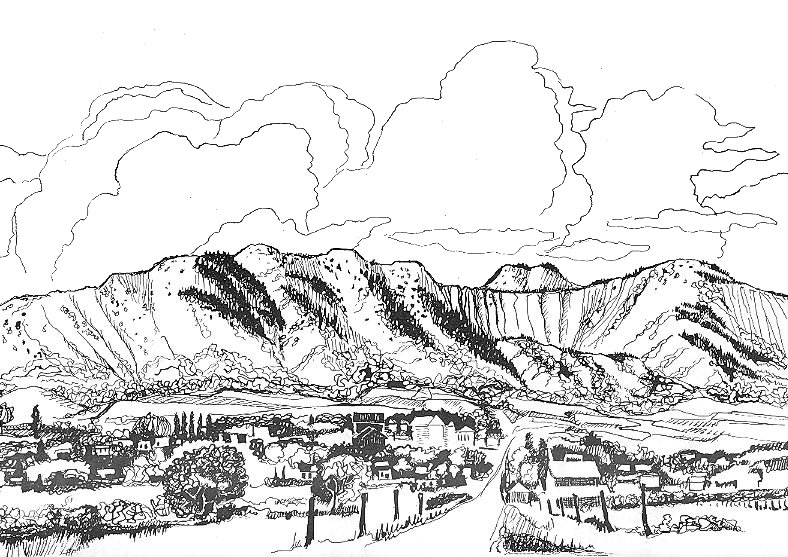 |
Cache Valley is a broad arid valley in Northern Utah and Southern Idaho. It extends approximately 50 miles along the west side of the Bear River Mountains, the northernmost extension of the Wasatch Range, and along the east side of the Wellsville Mountains (in Utah) and the Bannock Range (in Idaho). It is drained by the Bear River and its tributaries, into the watershed of the Great Salt Lake.
The abundance of springs and cold mountain streams could provide water for culinary use as well as for irrigation. There were bear, rabbits, deer, and numerous game birds that inhabited the mountains and lush grasslands. The trees were plentiful too and could be used for firewood, fence posts, and lumber for building homes, barns, and granaries.
Under the direction of Brigham Young in the fall of 1856, a group of Mormon pioneers settled in the south end of the valley where Wellsville is now. As the settlers began to prosper they began to create new settlements in other areas of the valley. One of their early settlements included Logan which was established in 1859 and became the prominent city. The eventual influx of people helped create the large number of towns that can now be found in Cache Valley.
Clarkston was one of these towns. It is tucked away in a secluded corner of the valley thirteen miles north and thirteen miles east of Logan, and five miles south of the Idaho boarder. The prominent landmark is Gunsight Peak, directly west of town. Several creeks flow down from the mountains, providing an abundant source of water. City Creek flows right through town.
Samuel Whitney first entered this picturesque setting while herding cows for Ezra T. Benson. In the year of 1864, under the direction of Ezra T. Benson and led by Isreal Clark – from whom Clarkston received its name and who was the first presiding elder – a group of pioneers came to establish a community. There were twelve families who remained through the severe winter of 1864-65. Upon arriving in the area, they immediately began building shelters and putting up hay.
The first homes were dugouts, with a fireplace in one corner and furnished with the most necessary articles of home-made furniture. The first houses were built by Andrew McCoombs, Gideon Harmison, and James Clark. Logs were sawed into lumber by the use of a saw-pit. The saw-pit was made by digging a hole in the ground and constructing a frame across the pit to hold the log in place. Two men, one in the pit and the other on top using a cross-saw, sawed the logs into lumber. Later a turning wheel was used for making table and chair legs, rolling pins, etc. Chairs were made by stretching rawhide across the frames. Holes were bored in the log walls and posts were attached to make a bedstead; rawhide strips served as springs and mattress.
The following spring brought more families, including John and Mary Pittaway Godfrey. John was the the first to put a plow in the ground in Clarkston. In the fall of 1865, a combined church and school house was built. It was a log structure forty by twenty-four feet. It was built on the southeast corner of the public square.
By 1866 several families had established their homes in Clarkston to the dismay of the Shoshone Indians who claimed the land west of the Bear River. The Indians set up camp on City Creek, just outside of town. Chief John, son of Chief Washakie, led the Indians into the settlement and demanded beef and flour from the settlers. Brigham Young determined that it was better to feed the Indians than fight them. But when their food supplies dwindled they were unable to meet the demands of the Indians. It was advised that they abandon their homes and relocate to Smithfield.
The following spring, the pioneer families returned to their farms. During their return Joseph Godfrey, the seventeen year old son of John Godfrey, drowned in the Bear River. They built their homes on the north and south side of a street forming a fort. The fort was about two blocks long running east and west. A militia was formed consisting of a horse company and and an infantry company to keep the Indians in check. During the trouble, one Indian was killed.
In the fall of 1867 the Clarkston Ward was organized with William F. Rigby as Bishop. The Sunday School was organized the 27th of November 1867, with Henry Stokes as Superintendent. Henry Stokes was also hired to teach school for the winter quarter and the people agreed to pay three dollars per student.
As the settlers endured the severe winters and heavy snowfall, they began to consider moving the town to a new site. In 1868 a new location for Clarkston was identified about five miles south of the present city. During the summer, ditches were made to take water to the new site. A fence was built along Birch Creek to pasture cows and animals.
The Relief Society was organized 16 August 1868 with Isadore Beck as the president. On December 1, 1868, Franklin W Young, Henry Stokes, and Andrew W. Heggie made a petition for a mail route and post office. Thomas Beck was appointed to carry the mail for the winter and he was to receive one-half bushel of wheat for each trip. A semi-weekly mail was established in February 1869, from the Bear River station to Clarkston at $2.00 a trip or $4.00 a week. The post office was established in 1870
A Co-operative Store organization was formed in May, 1869. They adopted the same rules and regulations as Zion's Co-operative Mercantile in Salt Lake City. The Relief Society organization as well as individuals were urged to buy stock; the school trustees were asked to invest their funds at one and one-half percent interest. It was commonly known as the Co-op Store. On December 20, 1868, the school trustees arranged for a permanent school to be built. J. H. Barker was hired to teach school at ten dollars per week.
In these circumstances, Clarkston continued to grow as more settlers arrived. Among the new settlers were David Buttars in 1868, George Godfrey (the son of John Godfrey) in 1870, Maurice Gover in 1871, and Peter S. Barson later in 1876.
Preparations for moving to the new location was well under way in 1870, but many of the settlers were averse to an actual uprooting. The town's people were pulled three ways. Flood waters often covered the low ground where the fort stood and some lots to the east had been condemned. The present town site was selected and people began purchasing lots on this higher ground; others objected to moving the town at all; but the greatest controversy arose over moving the town to where Newton is now located. On February 28, 1869, under the direction of Bishop W. F. Rigby, a meeting of the settlers voted 29 to 3 to move to the new location.
There was bickering between Clarkston and Newton over which town should have the name of Clarkston. President Brigham Young deemed it necessary to visit each settlement and settle the dispute. It was on June 4, 1870, while holding a conference in Logan, that he made his visit to Clarkston and Newton. President Young gave the people of Clarkston permission to stay, but recommended that they move to higher ground.
The event of President Young's visit to Clarkston has become legend. The
people of Clarkston were discouraged, but when they knew
their beloved leader, Brigham Young, was coming to town they took
fresh hope. The women
cooked the finest meal possible
and made ready for President Young's arrival. Soon he arrived in his
white-top buggy. The
men had erected a bowery and a great crowd gathered to hear the
prophet. President
Young stood at the pulpit, turned completely around pointing with his
cane to the hillside and said, “All of this land will yet be
covered with grain.”
He said, “You harvest with the scythe and the cycle, but the time
will come when you will raise big crops of grain, even to the tops of
these mountains and you will sit under a parasol to harvest it.”
This made the people laugh. He went on to say he had never seen a
finer location for a town. “Be friendly with the Indians and you
can settle both towns. Those
who wish to go to Newton, go there; those who wish to stay in
Clarkston, stay here." 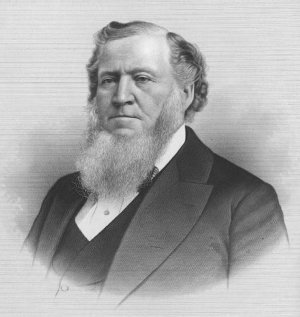
Brigham Young
At this time dry farming was unheard of, but with the prediction that grain would be produced on the dry areas north, east and south of Clarkston, the farmers began experimenting with different kinds of grain, and an era of prosperity opened. Some of the finest dry farming ground is found in the Clarkston area and is known as the granary of Cache Valley.
The survey for the new town site was made by James Henry Martineau, the county surveyor. The patent for the town was received from Milton Hammond, the probate judge, and the people received their deeds from him. Without making a new deed, the seller handed over his deed to the buyer. The people moved to their new lots in 1870-71.
The town was laid out in blocks: three north and south and three east and west, with houses on both sides of the street. The architecture of the homes was very similar. People first built two room houses and as their family and finances increased they added a kitchen and dining room and connected them with a large L shaped porch. In every back yard was a well with a bucket tied to a rope. There was a chopping block sprinkled with chicken blood; among the chips lay rooster heads with glazed, half-open eyes, mute evidence of many a fine dinner. In a corner stood a whitewashed privy stocked with a can of ashes and a Sears Roebuck catalog, and sometimes some old newspapers. Here one could retire with impunity and rest or read. Every lot had a row of plum trees. Under them sat a few farm implements profusely sprinkled with droppings of chickens and birds. Close by, the straw-covered stable provided shelter for a team of horses and a milk cow or two. Nearby stood a log hen house without windows. Five or six sleek porkers peeked up over a crude pen, and these, with the dog, a few cats, and the roosters, completed each barnyard orchestra. Neighbors shared freely. Starts of yeast went from house to house, along with bread and fresh honey, followed at butchering time with fresh meat.
During the 1870s the hardships of pioneer life began to ease. As the next generation, including Daniel Buttars, Emma Gover, Joseph Godfrey, and Eliza Barson began growing up in Clarkston, new homes were built, accompanied by barns, granaries, and gardens. A woolen mill was erected. Clarkston and Newton were still fording the Bear River to get across the valley. In January and February of 1871 a bridge was built across the river. The bridge was one hundred and nine feet long. This was a considerable step forward in transportation and communication.
It was this year, that the Clarkston settlers experienced the miracle of the seagulls. Three times the crops were eaten down by the crickets, and three times the gulls came and devoured the crickets. Each time the tender new grain grew again and the fall harvest was good. David Buttars raised a record crop of 1,300 bushels.
The building of the railroad from Ogden to Soda Springs was a boon to the people in 1871. The Tithing Granary was also built in 1871. Here tithing grain and other donation produce was stored. Donation hay was stacked in the yard.
In 1874 Martin Harris, one of the three witnesses to the divinity of the
Book of Mormon, came to Clarkston to live with his son, Martin
Harris, Jr. The little white haired man was often seen on the
streets of Clarkston. He freely bore his testimony to all who would
listen. In 1875 he was stricken with paralysis and was confined to
his home. He died 10 July 1875 and was buried
in Clarkston Cemetery.

Martin Harris in 1870
George Godfrey was the sexton of the Clarkston Cemetery for many years and was directly involved with the preparation of the graves and the burials, including that of Martin Harris. Sometime during the 1880s, it was proposed to exhume the remains of Martin Harris and have them buried in Smithfield. The mere idea outraged the citizens of Clarkston who had cared for him during the last year of his life. To make sure that such a thing would never happen, George with the help of his sons Harry and Joe leveled off the grave and with a team of horses drug one of the huge stone steps from the old church and placed it over the grave. Needless to say, the grave remained. The stone can still be seen level with the lawn in front of the monument.
The cornerstone for the new meetinghouse was laid the first of May 1877
and the building was completed and dedicated in the fall of 1877. It
was a rock structure fifty-six by thirty-six feet. It ranked as one
of the finest in Cache Valley outside of Logan. It was built by
donation and cost $4,000.00. The dedicatory service lasted two days.
Apostle Moses Thatcher offered the Dedicatory Prayer. 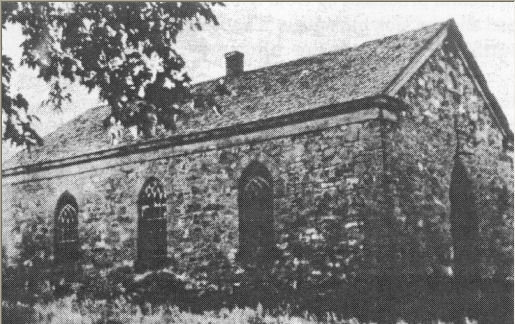
The Rock Meetinghouse built in 1877
It was lighted by a crystal chandelier with six branches covered with a crystal lamp on each arm. There was not an organ, so Peter Barson hauled his organ back and forth so they could have accompaniment for the singing in the meetings. The meetinghouse was also used for dances and other social gatherings.
The ground breaking ceremony for the Logan Temple was held on May 17, 1877. President Brigham Young and other general authorities attended. Orson Pratt knelt near the broken ground and gave the dedicatory prayer. The Clarkston Ward Choir sang at this service.
Seven years later, on Saturday 17 May 1884 the Temple was dedicated. President John Taylor, who succeeded Brigham Young, gave the dedicatory prayer. The following Sunday the services were repeated; and again on Monday when Joseph F. Smith read the prayer. Tickets were issued for each session and each day throngs ascended the spiral stairway to the upper temple assembly hall. The following Wednesday ordinance work began, and every day, within the confines of this great edifice, hundreds of people receive spiritual blessings and privileges.
A new rock school house was built of native rock in 1886 at the cost of
$2,000.00. Because of the geographical isolation of Clarkston, the
people became self-sufficient. In the schoolhouse the children
learned reading writing, and arithmetic.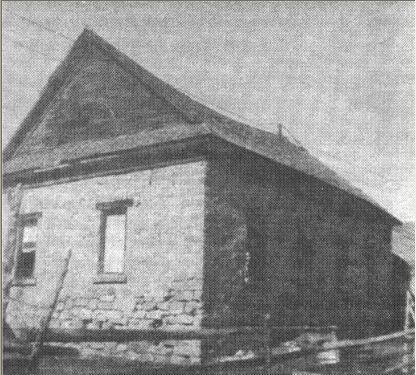
The school built in 1886
There were three midwives who delivered the babies: Aunt Caroline (Griffin Thompson), tall and stern and commanding, Aunt Marthy (Martha Gover Griffin), a prim little English woman with her hair in a little bob on top of her head, and Aunt Agnes (Jardine Shumway), always immaculate in a fresh white apron with knitted lace along the bottom. Birth was a natural process and too often complications resulted in the loss of the baby or the mother, sometimes both. These women were on call night and day for the sum of $8 (or less if the family could not afford it).
Thomas Godfrey pulled teeth while his wife retired to the cellar so as not to hear. Jack Thompson with his long curled white mustache set the broken bones and always told jokes during the painful process. Jim Thompson, the carpenter, made the caskets of native lumber and lined them with white outing flannel. Sometimes he covered them with black or white velvet depending on what was available, but the dead never wanted for a neat, substantial coffin. The townspeople's needs were complete with short, stocky Joe Myler who led the choir and fiddled for the dances.
The voice of Clarkston in the Logan Herald flowed from the pen of Sanko, otherwise known as Peter S. Barson. Readers throughout Cache Valley delighted at his wit which was reflected in the human interest stories, community events, and other news that he reported on. On the more serious side, the obituaries that he wrote were always a fitting eulogy on the life of the recently departed.
The Larson Sisters' store was established in 1896. It was located in the northwest part of town on a small hill and was in the family home, which also served as the post office. Goods sold were ordered from Salt Lake, Ogden, and Logan, and were shipped by train to Cache Junction where Lars Larson picked them up and hauled them to Clarkston by horse and wagon.
Utah became a state in 1896 and by 1900 the Clarkston Ward had grown to 628. The rising generation, which included Gover Buttars and Mary Eliza Godfrey, enjoyed the fruits of the efforts that their parents and grandparents and others had put forth to make Clarkston what it was at the turn of the twentieth century. The town of Clarkston was formally incorporated in 1901 with Thomas Griffin, president; Ole Petersen, George Godfrey, Alfred Atkinson and James B. Jardine, trustees.
Until 1901 Clarkston belonged to the Cache Stake. On the 30th of April 1901 the Benson Stake was organized with William H. Lewis, president. The Benson Stake consisted of the Amalga, Clarkston, Cornish, Cove, Lewiston 1st and 2nd, Smithfield 1st, 2nd, and 3rd, and Trenton Wards.
A Prayer Circle Group was organized in Clarkston by Bishop John Jardine on June 23rd 1901. David Buttars offered a room in his home for the Prayer Circle to meet in. The room was dedicated for that purpose. Permission for this organization came from the First Presidency of the Church through the President of the Logan Temple. Samuel Roskelly was sent from the temple to affect the organization. Twice each month the members of this group met in David's home, with Bishop John Jardine presiding. The purpose of the prayer circle was to give thanks and recognize the mercies and blessings from God. A petition for temporal and spiritual blessings was invoked. And a restoration of health for the sick was asked for.
In 1908 the installation of a water works system was initiated under the direction of Daniel Buttars and Andrew Heggie. Deep trenches began to worm their way through the town. Much of the excavation work was done by Joe and Harry Godfrey with their horse drawn equipment. Occasionally a child slipped into a trench and was hoisted out by a jovial worker. One day a flirtatious young lady experienced the same slip and attracted quite a crowd in the trench and on the banks. Her recovery? Well, as the historian says, "a good time was had by all."
Wooden pipes were installed in the system but they soon had to be replaced.
The assessment for a hydrant was three or four hundred dollars. The
flow of cool, clear water at the twist of a tap was an appreciated
improvement over the old pumps and wells, and opened the doors to
modern plumbing. 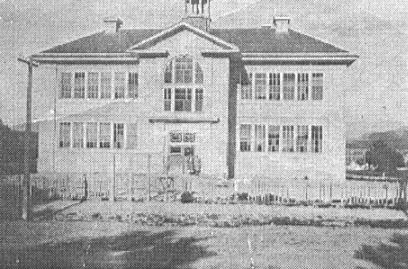
The brick schoolhouse
Construction on a new school was begun in 1909 and a church house in 1910. In the summer of 1910, due to financial difficulties, the contractor for both buildings was unable to honor his contracts. Claypool Lumber Company completed the school house before the school year began. The two-story building was of light brick with two classrooms on each floor; a belfry topped the building. Through the years it has been remodeled and new facilities added.
The Anderson Lumber Company completed the church house. The stone for the footings and cesspool was hauled from local quarries by donated labor. The cement basement contained classrooms, dressing rooms, furnace room and a baptismal font. The beautiful chapel with high-domed ceiling from which an ornate chandelier hung, a circling balcony, choir loft, rostrum and a bishop's room covered the main floor. A second story consisted of a Prayer Circle room and an adjacent room. The chapel seated eight hundred people. The cost of the construction was twenty-eight thousand dollars.
The building was dedicated July 20, 1913. Apostle Francis R. Lyman
offered the dedicatory prayer. The Clarkston choir under the
direction of Joseph Larson furnished the music for the dedication and
also for a two-day conference of the Benson Stake which was held in
the new building. The building was decorated with garden flowers and
potted plants.
The new meetinghouse dedicated in 1913
After the close of conference, Sister Garrett Dahle collected her treasured geranium blooms, which had adorned the chapel, and was leaving the building when a young boy sped up the street with the stunning news that her son, William, had drowned in the reservoir. Sister Dahle's flowers fell to the ground to be trampled by the excited crowd as she sped away. The newly dedicated chapel lent grace and dignity to the funeral of her twelve year old son, William Izatt Dahle. These two events will always be remembered together.
Each year the men went together to clean the irrigation ditches leading into town that watered the farms and gardens. They were given credit for hours worked to help pay their water bill. While the men were cleaning ditches, the wives got together and made the best supper ever.
The homemakers of Clarkston tended to be a bit competitive in their household labors. A contest held among the women in town was to see who would have the first line of clothes whipping in the breeze. It was whispered that some determined ladies actually wet down clean sheets and raced to the line to pin up the first Monday wash each week.
A franchise for the electric lights was investigated in 1913 and granted in 1916. A house-to-house canvas was made to promote the project. When the lights were installed the people paid one dollar per month for this utility that was to transform and elevate all modes of living.
Just when the first telephone was installed in Clarkston is uncertain, but it was located in the Co-op store. A. M Musser, "Brigham Young's Traveling Bishop" and manager of the Deseret Telegraph for many years, introduced the telephone in Utah in 1878. Logan had a switchboard in 1886 and by 1905 most of the valley was supplied. Thomas Griffin, manager of the Co-op store, carried on a game of checkers over the phone with a friend in Newton. This supplied a lively interest for those who would gather around the stove to "chew the fat." In early days the folks, before answering a call, would smooth their hair and straighten their cloths, as if the person on the other end of the line could see them.
The first automobiles in Clarkston belonged to Daniel Buttars, Tom Buttars, and David Dahle. David's was a brand new 1915 Buick. He was so used to driving a team of horses that he called “whoa” to his car when he wanted it to stop. At one time, he lost control of his car and knocked out the boards in the end of the shed he was using for a garage. He filled two sacks with dirt and placed them on the floor so the car would stop when the front wheels ran up against them, in order prevent another accide
nt. With a car, it now only took about an hour to drive the twenty miles to Logan compared to over four hours by horse and buggy.
The Great War (later known as World War I) began in 1914 when the heir to the Austro-Hungarian throne was assassinated, a chain of events set off declarations of war that involved all of Europe. Americans were thankful for their position across the seas and felt strongly that there should be no entangling alliances, and that Europe could "stew in her own juices."
President Woodrow Wilson favored U. S neutrality. The Central Powers in the conflict were Germany, Austria, Hungary, Turkey, and Bulgaria. The Allied Powers were Britain, France, Russia, Japan, and Italy. America, the great melting pot of all nations, now began to make deferential references to her citizens such as German-Americans, French-American, etc.
Food became the greatest factor in the war. With the slogan, "Food will win the war," food commodity prices soared. Clarkston's waving grain fields became literally golden as America poured wheat into France and other countries. Clarkston farmers prospered. President Wilson was re-elected on a slogan, "He kept us out of war, " still, many people had flamed with indignation at the sinking of the Lusitania on May 7, 1915. In 1917 German submarine warfare and the sinking of four unarmed American merchant ships, taking American lives, forced the President's hand and thrust the United States into war against Germany.
Food was rationed. National "meatless days" and "wheatless days" were initiated; substitutes for wheat flour were introduced, some of which were very palatable, but the dark potato bread was deplorable. Still America's discomfort was nothing compared to that of war-weary Europe, and in rural communities where raising food was a business, no one suffered hunger.
Clarkston women, old and young, with their children gleaned wheat from the fields, zealously and diligently. Within a few years they built a storage granary. When the government bought the wheat, Clarkston wheat amounted to $1,714.98 from which they received a yearly interest dividend. Plans for community improvements were made for the time when the principal would be paid. Later, however, it was presented and voted upon in Stakes and at a general Relief Society conference that the money should not be returned to the wards but should be used for other charitable projects. The Clarkston Relief Society reluctantly abandoned their plans.
At the beginning of the war, draft deferments were given to farm laborers, but as more blue and gold stars appeared in home windows. As farm boys enlisted, women donned the overalls and took to the fields. Throughout the nation and the world women were employed in all kinds of labor.
The Armistice was signed on November 11, 1918. Clarkston suffered no war casualties. Trailing clouds of war and hunger are disease and death. In 1918, an epidemic of the Spanish Influenza seized the nation taking a toll of many lives. It was introduced into the country by the soldiers returning from Europe. The disease gripped Clarkston in the winter of 1918-1919. On November 18th a quarantine was placed on the town. Schools and churches were closed. The people banded together as one family to combat the disease. Wearing masks, the able ones entered in and out of each others' homes attending the sick, bringing food, doing housework and chores. Townspeople recall Virgil Atkinson and other young men going from one place to another doing outside chores all winter long. Three deaths were attributed to the influenza in Clarkston.
Following the war there was was an extremely sharp deflationary recession in the United States. In the depression of 1921 wheat that had sold for $1.95 in 1920 dropped to 65 cents. Many farmers who had gone into debt during the boom years now felt the pinch of declining prices. In order to hold onto their property, many were forced further into debt and some lost their farms and homes.
Another controversy arose over the gravesite of Martin Harris in 1923. This
time the Logan Chamber of Commerce started a movement to have the
remains of Martin Harris moved to Logan. This caused agitation and
disputation.
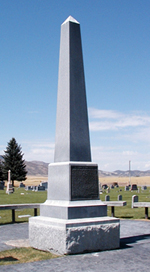
Martin Harris' grave site
The finger had been pointed at the Clarkston Cemetery. Heretofore, the busy farmers considered one good spring cleaning before Memorial Day sufficient. Russian thistle, June grass, and tumble weeds were considered the common lot of man. Now a beautification program for the town and cemetery began. In 1924 President Heber J. Grant made arrangements to erect a monument over his grave and in 1925 the Martin Harris Monument was erected. An annual pageant is held in Clarkston honoring the “Man Who Knew”.
In 1930 the population of the Clarkston Ward was 662, having been reduced by six when Gover Buttars moved his family to Burley, Idaho in 1929. Clarkston went on without them, but life for his family was never quite the same.
The main source for this story was A History of Clarkston by Eunice P. Ravsten in Clarkston; The Garnary of Cache Valley and a history included in the Ancestors and Descendants of Lydia Gover and John Ezekiel Godfrey compiled by Lydia G. Benson and Theo G. Buttars. Other pieces come from various life stories. Since this story is a supplement to the life stories of the ancestors of Gordon Gover Buttars, it ends at the time his father moved from Clarkston.